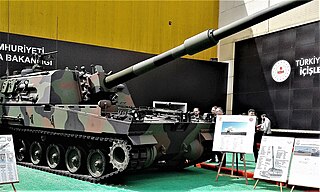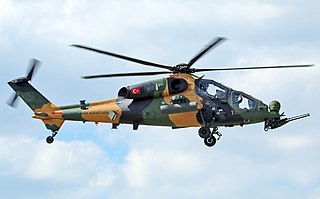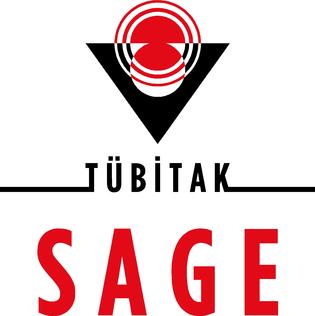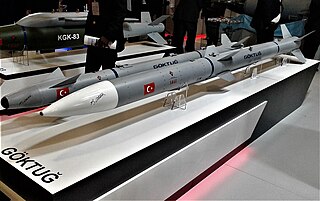Related Research Articles

The Avenger Air Defense System, designated AN/TWQ-1 under the Joint Electronics Type Designation System, is an American self-propelled surface-to-air missile system which provides mobile, short-range air defense protection for ground units against cruise missiles, unmanned aerial vehicles, low-flying fixed-wing aircraft, and helicopters.

The Oerlikon GDF or Oerlikon 35 mm twin cannon is a towed anti-aircraft gun made by Oerlikon Contraves. The system was originally designated 2 ZLA/353 ML but this was later changed to GDF-001. It was developed in the late 1950s and is used by around 30 countries.

Aselsan, Aselsan A.Ş., is a Turkish defense corporation headquartered in Ankara, Turkey. Its main operating area is research, development and manufacture of advanced military products for air, land and maritime forces. The company is one of the major contractors of Turkish Armed Forces. Aselsan was ranked by Defense News as 48th largest defense company in terms of revenue. Turkish Army Foundation is the founder and major stockholder.

The TAI Anka is a family of unmanned aerial vehicles developed by Turkish Aerospace Industries primarily for the Turkish Air Force. Envisioned in the early 2000s for aerial surveillance and reconnaissance missions, Anka has evolved into a modular platform with synthetic-aperture radar, precise weapons and satellite communication.

T-155 Fırtına is a Turkish variant of K9 Thunder 155 mm self-propelled howitzer originally developed by South Korea. It is manufactured and assembled by Turkish Land Forces at the 1010th Army Equipment Repair Factory using imported subsystems from Korea. It has an ongoing upgrade project dubbed as T-155 Fırtına II, possibly changing its engine to Turkish origin to avoid Germany's restriction on Turkey's defense sales.

UMTAS or Mizrak-U(Uzun Menzilli Tanksavar Sistemi) is a modern long range air-to-surface anti-tank guided missile developed by Turkish armor and missile manufacturer Roketsan.

Roketsan Roket Sanayii ve Ticaret A.S. is a Turkish weapons manufacturer and defense contractor based in Ankara, Turkey. Incorporated in 1988 by Turkey's Defense Industry Executive Committee (SSİK) to establish the nation's industrial base on missile technology, the company has quickly risen to become one of Turkey's top 500 industrial corporations.

The TAI/AgustaWestland T129 ATAK is a twin-engine, tandem seat, multi-role, all-weather attack helicopter based on the Agusta A129 Mangusta platform. It was developed by Turkish Aerospace Industries (TAI) in partnership with Leonardo S.p.A. The helicopter is designed for armed reconnaissance and attack missions in hot and high environments and rough geography in both day and night conditions.
FNSS Savunma Sistemleri A.Ş. is a Turkish defense manufacturer founded in 1988. It is owned 51% by Nurol Holding of Turkey and 49% by British–American firm BAE Systems Inc., and operates facilities located in Gölbaşı, Ankara.

TÜBİTAK Defense Industries Research and Development Institute, shortly TÜBİTAK SAGE, is a Turkish institution carrying out research and development projects on defense industry technology.
ACV-30 is the designation of an armored combat vehicle developed by the Turkish defense company FNSS Savunma Sistemleri A.Ş.

The Hisar is a family of short, medium and long-range surface-to-air missile systems being developed by Roketsan and Aselsan since 2007. The missiles are developed by Roketsan, while most sensors and electronics are developed by Aselsan. The missile family consists of the short range Hisar-A, medium range Hisar-O, the 100 km long range Hisar-U and the 150 km air defence system SİPER. Missile seeker of Hisar-A and Hisar-O is infrared homing.

Bayraktar Akıncı is a high-altitude long-endurance (HALE) unmanned combat aerial vehicle (UCAV) being manufactured by the Turkish defence company Baykar. The first three units entered service with the Turkish Armed Forces on 29 August 2021.

GÖKTUĞ is a Turkish program by TÜBİTAK-SAGE to develop four variants of air-to-air missiles that are to be launched from F-16s as well as future Turkish indigenous Hürjets and TF-Xs. These missiles are going to be Turkey's first indigenous air-to-air missiles. Bozdoğan (Merlin) is short-range infrared homing missile and Gökdoğan (Peregrine) is a beyond-visual-range active radar homing missile.

The KORKUT is a Turkish all-weather-capable 35 mm self-propelled anti-aircraft gun (SPAAG) developed by Aselsan.

BMC Vuran is a Turkish made Mine-Resistant Ambush Protected (MRAP) vehicle built by BMC. Vuran is designed and manufactured by the Turkish armored vehicle manufacturer BMC to meet the requirements of the Turkish Land Forces. Vuran means Striker in Turkish.

The OMTAS(Orta Menzilli Tanksavar Sistemi), also known as Mızrak-O, is a Turkish medium range anti-tank guided missile developed by Roketsan. OMTAS is an advanced system with various types of latest technologies, effective against modern armored threats on the battlefield. OMTAS is likely to replace current 152 mm BGM-71 TOW and 103 mm MILAN in Turkish service.
References
- ↑ "Turkey tests mid-range air defense system". www.aa.com.tr. Retrieved 2020-03-07.
- ↑ "ATILGAN Pedestal Mounted Stinger System | ASELSAN". www.aselsan.com.tr. Retrieved 2020-03-07.
- ↑ "TURKISH DEFENCE INDUSTRY PRODUCT CATALOGUE". www.ssb.gov.tr. Retrieved 2020-03-07.
- ↑ "The Turkish PMADS". tanknutdave.com. Retrieved 2020-03-07.
- ↑ "Hollanda Kraliyet Ordusu Aselsan'la hedefi vurdu". www.hurriyet.com.tr (in Turkish). Retrieved 2020-03-07.
- ↑ millisavunma (2017-03-25). "Atılgan ve Zıpkın Hava Savunma Sistemi". Millisavunma.com (in Turkish). Retrieved 2020-03-07.
- ↑ millisavunma (2017-03-25). "Atılgan ve Zıpkın Hava Savunma Sistemi". Millisavunma.com (in Turkish). Retrieved 2020-03-07.
- ↑ "info sheet" (PDF).
- ↑ millisavunma (2017-03-25). "Atılgan ve Zıpkın Hava Savunma Sistemi". Millisavunma.com (in Turkish). Retrieved 2020-03-07.